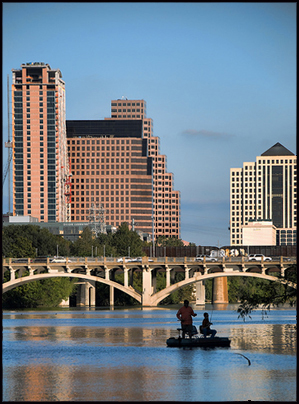
Recently, the Editorial Board of the Austin American Statesman has made a wise observation:
It is very difficult for a man or woman to gain stability, get and keep a job, recover from substance abuse or stay out of jail if they are living on the street or in a temporary shelter.
Somebody in that group comprehends a basic concept that many housed people fail to grasp. If you’re homeless, how do you get a job?
Where do you keep your social security card and birth certificate and a tattered copy of your most recent resume, saved from back when you had access to a typewriter or a word processor? How do you wash and iron your shirt? Where do you shave or style your hair? Where do you leave the rest of your stuff when you go to apply for this job? Will the guard in the office building lobby watch your duffel bag for you?
The Editorial Board marked the end of National Hunger and Homelessness Awareness Week by publishing a piece called “Better approach needed for housing the homeless.” It recaps how the City Council plans to create 350 units of permanent housing, and some of the difficulties the project will face. It goes on to say that the same problems apply to a proposed RV park. The City Council likes the blending and integrating approach better, the proposed Marshall Arms Apartments in particular. The Editorial Board says,
Ideally, permanent housing for homeless people would be matched with a host of services to address their medical, mental, employment and social needs, giving them their best shot of overcoming factors that keep them down and out.
So we’re looking at how one city is attempting to cope with a situation faced by many cities. Below is the reaction of a local Austin citizen, intimately familiar with the workings of the municipality, Richard R. Troxell, founder of House The Homeless:
The lead editorial stated that a ‘Better approach (is) needed for housing the homeless.’Our organization, House The Homeless, could not agree more. The paper praised the City Council for creating 350 units of permanent supportive housing, as do we. But in searching for a better approach, let’s consider that it took our community almost 10 years to create a Housing Trust Fund and pass a bond that produced the millions of dollars needed for the 350 units. It is also estimated that the units will be built over four years with the push past NIMBYism taking an additional two years, if then. (In other words, one of the forces to be dealt with is the tendency of residents to react by saying, ‘Not In My Back Yard.’)
And that’s only 350 units. With 4,000 folks experiencing homelessness, to get everybody housed would bring the total to 11 times that amount, at a cost of half a million dollars per person, and a response time of a couple years. We can hardly wait that long, not with 159 names of men, women, and baby girl Vasquez having been read this year alone at the Homeless Memorial.
Now, add into this equation that the Federal Government (according to the last several US Conference of Mayor’s Reports) has set a minimum wage so low that even a full-time worker cannot afford basic housing anywhere in this country! Instead, 40-hour-a-week workers are unable to afford the basics of food, clothing, and shelter. They end up living under bridges, in our woods, and panhandling for survival on our streets.
House The Homeless views those experiencing homelessness in two categories: those who can work and those who cannot work. As a taxpayer, am I expected to take care of all 3.5 million people experiencing homelessness nationwide? I gag at the thought. HTH completed a survey in January, of 501 people experiencing homelessness in Austin. The results exposed that 52% of the homeless can work but are lacking one thing… opportunity. If the only roof the full-time worker can expect is a bridge… then why bother? The alternative of selling drugs or the girl down the street is a lot easier and much more rewarding financially.
So, here’s how to cut the need for subsidized housing in half — by employing that 52% who just need an opportunity and a job that pays enough to live on. Then they can make their own housing arrangements. Then taxpayers only need to be concerned with the other half, the people experiencing homelessness who are unable to function as full-fledged participants in the economy. With the entire population need reduced by half, and the remaining folks being so vulnerable and needing focused support, then collective site programs such as the Mobile Loaves and Fishes mobile home park, just might be the thing.
Again, for those who can work, let’s consider the idea where the Federal Minimum Wage ensures a Living Wage: enough to afford the very basics; food, clothing, shelter (including utilities), as both halves of Congress had originally intended following the last depression. Wouldn’t the result be better all around? See House the Homeless for complete information on the Universal Living Wage.
Reactions?
Source: “Better approach needed for housing the homeless,” Austin American Statesman, 11/20/10
Image by Krikit, used under its Creative Commons license.


